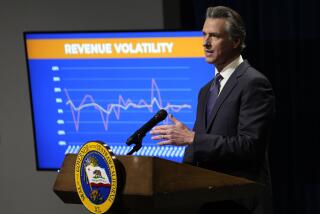Column: Political Road Map: California has $55 billion in tax breaks, and many are here to stay

- Share via
Everyone loves paying less in taxes. And politicians certainly enjoy making their constituents happy, which means that proposals for creating new tax breaks are a perennial favorite in Sacramento.
There’s just one hitch: Tax breaks cost money, in the form of lower government revenue.
That trade-off really gets revealed only when tax time rolls around. Once the state’s billions of dollars in tax revenue are counted, it’s up to Gov. Jerry Brown and lawmakers to divvy up the cash for California’s many needs, including schools, law enforcement and environmental protection.
But there would be a lot more money if not for the state’s hundreds of small and large tax breaks. How much more? A 2015 report by the independent Legislative Analyst’s Office concluded the total value of those breaks is around $55 billion, almost half the size of the state’s general fund.
That number could rise next year, if lawmakers have their way. A review of bills now pending in the Legislature shows a variety of new tax breaks being proposed. One eye-catching proposal, Senate Bill 807, would offer tax credits for anyone who earns teaching credentials. For those who go on to become teachers, it would exempt their entire salary from income taxes. The bill is slated to be heard in committee next month, and legislative staffers still are analyzing the fiscal impact.
Other ideas are smaller but include the kinds of tax breaks that add up over time. One legislative plan would increase the size of an existing tax credit for renters. Another bill would offer a credit of up to $2,000 for veterinary expenses. A third would reduce taxes on farmers who flood their rice fields in the winter.
The most obvious challenge is to determine whether these are good ideas or whether they take too much tax revenue off the table. The winnowing of bills begins at the state Capitol in the next several weeks, with major decisions to be made this summer.
The most popular tax breaks are also the most costly. Top of the list in the most recent annual review by the California Department of Finance was the tax-free status of employer health benefits. The report concludes that alone is worth $5.8 billion. Other popular but costly laws exempt home mortgage interest and Social Security benefits from taxation.
No one is talking about canceling those breaks. But they’re also not talking about any of the hundreds of others that are on the books. The problem is that there’s often very little data on which tax credits are effective and which are not.
The 2015 analyst’s report concluded that it’s hard to assess whether most tax breaks “are effective and cost-efficient in achieving their objectives.”
Perhaps the biggest reason, though, that California tax incentives never get scrapped is because of what could best be called a case of legislative asymmetry. Simply put, tax incentives can be approved in the Legislature by a simple majority — 41 votes in the Assembly, 21 votes in the Senate.
But scrapping a tax break? Well, that’s considered a tax increase. Under the provisions of the landmark 1978 initiative, Proposition 13, a tax increase requires a supermajority vote in each house.
In the end, very few tax credits are ever rescinded. Their value and effectiveness are often trumped by politics. The perception of raising a tax, even back to its original level, is simply too high for many legislators.
Follow @johnmyers on Twitter, sign up for our daily Essential Politics newsletter and listen to the weekly California Politics Podcast
ALSO
Political Road Map: The rules for California school funding may lead to a surprising result in 2017
Political Road Map: California’s electoral future is rooted in the old-fashioned absentee ballot
Updates on California politics
More to Read
Get the L.A. Times Politics newsletter
Deeply reported insights into legislation, politics and policy from Sacramento, Washington and beyond. In your inbox twice per week.
You may occasionally receive promotional content from the Los Angeles Times.











